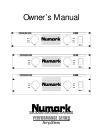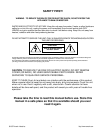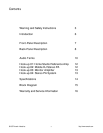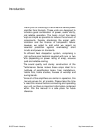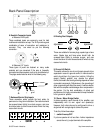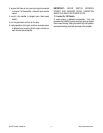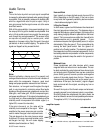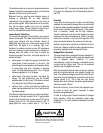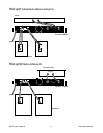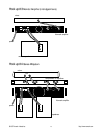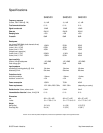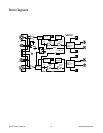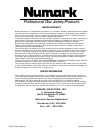
©1997 Numark Industries http://www.numark.com
7
Front Panel Description
1. Gain Controls
These two knobs are the level controls for each channel
of the amplifier. The gain increases as the knob is turned
clockwise. The SA5500 features detented gain controls
with dB calibrations to simplify set up.
2. Limit LED
If an audio signal is amplified beyond the limit of the
amplifier, the extremes of the signal will not reach the
appropriate levels, giving the appearance of being clipped
off when viewed on an oscilloscope. The audible result is
distortion, which in small amounts can lead to rapid ear
fatigue, and in larger amounts a harsh and unpleasant
breaking up of the sound which can damage speakers.
The SA5500 has a built in limiter on each channel to
prevent clipping. Should the signal reach a level high
enough to cause clipping, the limiter momentarily reduces
the level just enough to prevent it. The limit LED lights
whenever this occurs.
If your system has a dedicated compressor, you may
decide to use the limiting function of this instead. Although
the limiting function of the SA5500 has no noticeable effect
on the sound quality below clipping, some users may
seek to disable it. See feature 11.
3. Protect LED
The SA5500 features several types of protection to
prevent damage to the circuitry during turn on or fault
conditions. The power on protection relay prevents
damaging thumps to the speakers as the power comes
on. When the amp is switched on, the protect LED will
light for a few seconds and then go out, indicating that the
relay has closed, connecting the speakers to the
amplifier.
The protect light will also come on if the speaker terminals
are short circuited, or the impedance of the load between
them is too low. In these circumstances, the protect LED
will stay lit until the fault condition is rectified.
The amplifier’s large heatsinks, vents and fan should
provide enough cooling even with a high ambient
temperature. However, if the amp overheats, thermal
shutdown protects the circuitry until the temperature is
reduced to a safe level. Should the amp shutdown for
thermal reasons, leave the power connected to the amp,
try to improve ventilation, and reduce the gain. Without
power, the fan cannot operate, and the amp will require
longer to reach a low enough temperature to restart.
4. Signal LED
Each channel of the SA5500 features a signal LED to
show that there is an audio signal at the input to the
channel. The threshold for the indicator is -30dB, which
should be enough that noise doesn’t trigger the LED, but a
faint audio signal will.
5. Power Switch
This turns the amp on and off. Although the SA5500
features power on muting, it is nevertheless good practice
to reduce both the gain controls before turning on the amp.
The turn on procedure for powering up an audio system
should be to start from the instruments and mixer, and
verify operation before moving on to the power amps.
Once the amps are on, verify they are receiving a signal
and then slowly increase gain.



